No single stormwater treatment practice is appropriate for every site and condition. The applicability of individual practices varies depending upon both relatively simple physical constraints, as well as more complicated siting and treatment issues. This chapter addresses criteria to consider when selecting stormwater treatment practices for a particular site.
8.1 Stormwater Management Effectiveness
As discussed in Chapter Two, land development increases the potential for several stormwater related impacts. These impacts are largely a function of altering the natural hydrology at a site and increasing exposure to potential pollutants. Common stormwater impacts related to land development include degraded water quality, increased peak flow rates, increased runoff volume, stream channel erosion, and reduced groundwater recharge.
As discussed in Chapter Seven, stormwater treatment practices can achieve one or more of the following management objectives:
- Pollutant reduction
- Groundwater recharge and runoff volume reduction
- Stream channel protection and peak flow control.
Table 8-1 summarizes the relative effectiveness of each stormwater treatment practice in providing these management capabilities. The effectiveness ratings provided in the table should only be used to compare the relative management capabilities of different treatment practices. The ratings should not be used in an absolute sense to quantitatively predict actual field performance.
As described in Chapter Six, there is currently a lack of reliable performance data for stormwater treatment practices in the State of Connecticut. Additionally, the available performance data from past monitoring studies conducted throughout the United States are limited by differences in design, performance goals, site parameters, storm events, flow and pollutant loadings, seasonal variations, monitoring methods, and efficiency calculation methods or simply by the lack of or inadequate information. The reliability of pollutant removal efficiencies, which are often cited in guidance documents, is typically poor due to the large degree of uncertainty in the data. Additional performance monitoring using standardized methods and quality control procedures is recommended for new and existing stormwater treatment practices (see Chapter Six) in Connecticut to provide a more useful set of data on the effectiveness of individual stormwater treatment practices, and to better understand the relationship between treatment practice design and performance.

As shown in Table 8-1, most of these primary treatment practices are similarly effective at removing sediment, nutrients, and metals. Removal efficiencies are generally highest for sediment, while nutrient and metals removal efficiencies are typically lower. Infiltration systems are generally the most effective practices for removal of bacteria. Designs that incorporate floatable controls or pretreatment are most effective for removal of hydrocarbons. Treatment practices that incorporate biological removal mechanisms, such as constructed wetlands, are also more effective in removing pollutants than systems that strictly rely on gravity or physical separation of particles.
Many of these practices also have limited effectiveness in terms of peak flow control and groundwater recharge. Open bottom basins and dry swales provide some groundwater recharge, but only practices specifically designed as infiltration structures will provide significant levels of groundwater recharge. Many of these practices either have an impermeable bottom or are designed to intercept groundwater and thereby provide little infiltration. Similarly, attenuation of peak flows requires significant available storage capacity to temporarily store runoff as the peak flow is being throttled. Many stormwater treatment practices provide limited storage capacity or detention time and are inadequate as stand-alone flood control facilities. Separate facilities for peak flow control are often necessary to augment stormwater treatment practices.
A treatment train approach should be considered when faced with several sometimes competing demands when selecting treatment practices for a particular site. As discussed in Chapter Six, a treatment train consists of a series of management practices each designed to provide targeted pollution control benefits. For example, one practice may be selected for its ability to remove sediments while another may be better suited to remove dissolved pollutants.
8.2 Land Use Factors
Land use, both current and potential future use, should be considered when selecting stormwater treatment practices. Some practices are more “neighbor friendly” than others. Other practices are more land intensive and may be less desirable where space is at a premium. The following land use factors should be considered when selecting stormwater treatment practices.
Rural
Rural areas are typically characterized by low-density development (i.e., few neighbors) and relatively large amounts of available space. Stormwater treatment practices with larger area demands may be easier to locate with appropriate buffers in rural areas. Additionally, typical stormwater pollutants from rural areas include sediments and nutrients, which can be effectively managed by most stormwater treatment practices. As a result, most treatment practices are suitable for rural areas.
Residential
Medium- to high-density residential areas typically have limited space and higher property values compared to rural undeveloped areas. Also, treatment practices in these areas are likely to be located in close proximity to residences. Public safety and nuisance insects are common concerns for treatment practices in residential areas. Stormwater treatment practices with large land requirements or open pools of water may be less desirable in these areas. In some situations, stormwater ponds or other open water practices may be incorporated into the landscape as natural amenities to provide habitat, recreation, and aesthetic value.
Roads and Highways
Roads and highways typically generate high stormwater pollutant loads due to vehicle traffic and winter deicing activities. Sediments, metals, chlorides, and hydrocarbons are the primary pollutants associated with roads and highways. Nitrogen from vehicle exhausts and bacteria are also commonly present in road and highway runoff. As a result, most treatment practices provide some treatment benefit but do not adequately address all of the water quality impacts associated with this land use. In addition, open water and deep pools can also be a safety issue near roads and highways.
Commercial and Industrial Development
Commercial and industrial areas often have more intensive traffic, increased risk of spills, and exposure of materials to precipitation. Pollutants associated with these land uses can vary significantly depending on the nature of activities at each site, although traffic-related pollutants such as sediments, metals, and hydrocarbons are commonly present in runoff from most commercial and industrial sites. These developments may also have more available space for locating stormwater treatment practices.
Ultra-Urban Sites
Ultra-urban sites are the most restrictive in terms of treatment practice selection. These sites are characterized as having little available space or land area, high population density, and a wide range of potential pollutants.
Table 8-2 summarizes the compatibility of stormwater treatment practices with each of the above land uses, considering potential pollutants, public safety, nuisance insects, and land availability.
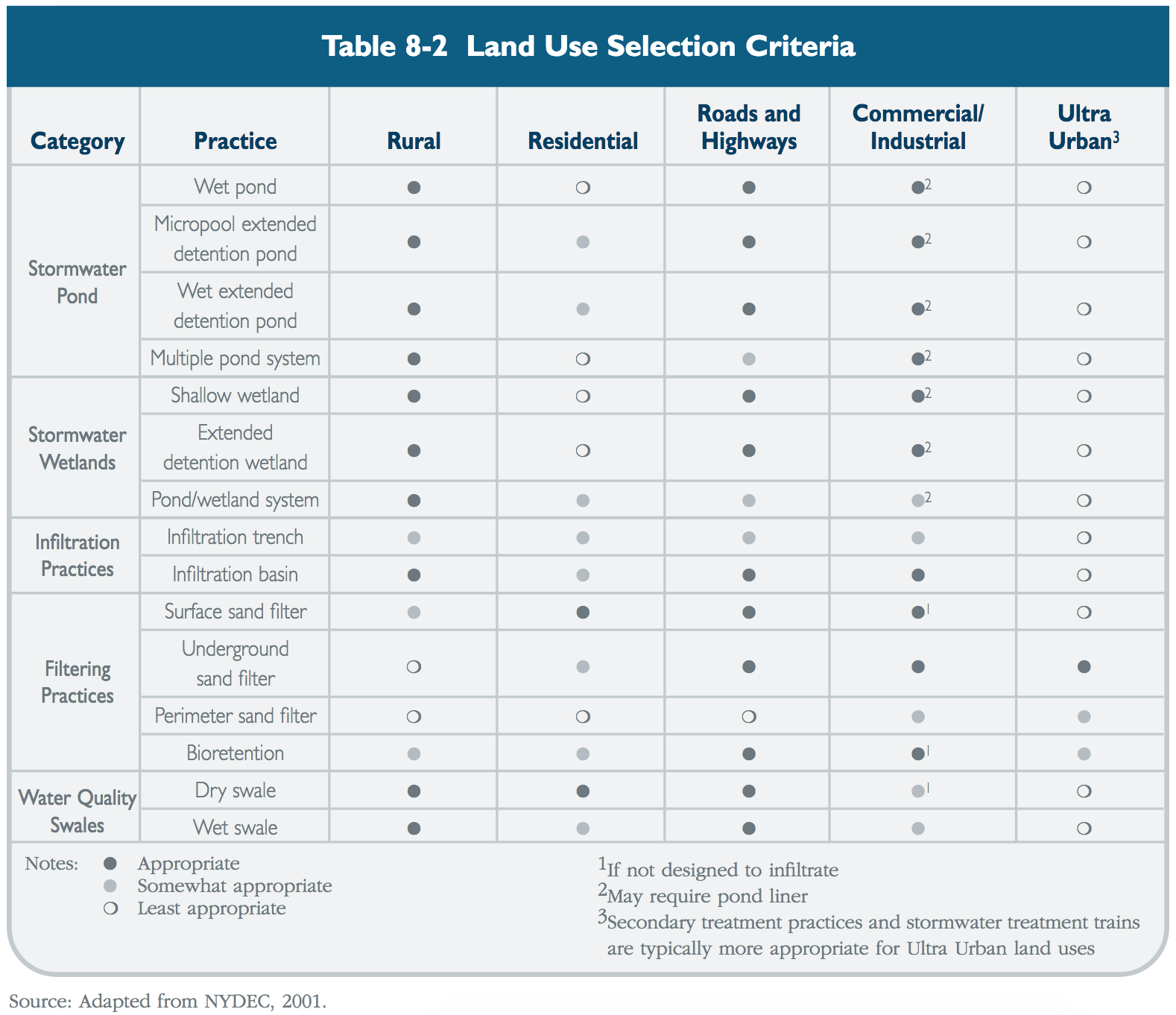
8.3 Physical/Site Feasibility Factors
Physical site constraints can also dictate the feasibility of specific stormwater treatment practices. These physical constraints can either make the installation of a particular treatment practice too costly or result in reduced or ineffective operation. While every site has its own individual characteristics that need to be evaluated, the five most common physical constraints that need to be considered are:
- Infiltration capacity
- Seasonally high groundwater (water table)
- Drainage area
- Slope
- Required hydraulic head.
These factors are discussed in general terms in the following paragraphs. Chapter Eleven contains additional information on physical feasibility and siting considerations for individual treatment practices.
Infiltration Capacity
Infiltration practices are highly dependent on the infiltration capacity of the underlying soils. Low soil infiltration capacity requires structures with larger infiltration surface area and storage capacity to account for slower infiltration rates. Higher soil infiltration rates allow for smaller infiltration structures. Accurate field measurements of infiltration rates are critical for the successful design and implementation of stormwater treatment practices that rely on infiltration of stormwater to underlying soils.
In Connecticut, the United States Department of Agriculture (USDA) Natural Resources Conservation Service (NRCS) has developed soil suitability rankings for various types of stormwater management practices, including infiltration trenches, underground infiltration galleries, stormwater wetlands, and stormwater ponds. The soil suitability designations are intended to facilitate proper selection and siting of stormwater controls and are based upon NRCS soil survey soil properties and landscape criteria. The information can be used to generate soil suitability maps for a town, watershed, or other designation. Soils are rated for each practice (suitable, fair, or good), and the specific limitations (slow infiltration, for example) are provided. This tool is intended to be used for initial screening of stormwater treatment practices and does not eliminate the need for on-site evaluation of soil characteristics for design purposes. Additional information on this program can be obtained from the Connecticut USDA NRCS (see Additional Information Sources at the end of this chapter).
Water Table
An elevated water table poses several design issues. The primary issue is the loss of storage and retention capacity in unlined treatment structures. If seasonally high groundwater exists above the bottom of an unlined pond or basin, groundwater will drain into the structure and fill or displace volume that may have been intended for retention. If a treatment practice is constructed below the seasonally high water table, the loss of storage capacity should be accounted for in the design, or engineering controls such as liners and/or underdrains should be considered.
An elevated water table may be advantageous for some treatment practices where a permanent pool of water is desired, such as stormwater wetlands. However, small separation between the bottom of a treatment structure and the water table may result in inadequate pollutant attenuation and treatment in the unsaturated zone. The potential for groundwater pollution due to stormwater infiltration is an important consideration in the design of stormwater treatment practices. Engineering controls such as impermeable liners may be required in these circumstances.
Buoyancy of structures installed below the water table is another issue related to a high water table. Below the water table, buoyancy is calculated as the weight of water displaced (i.e., the volume of the structure below the water table multiplied by the unit weight of fresh water or 62.4 pounds per cubic foot). The upward buoyant force may be large enough to displace a structure, sometimes out of the ground. Engineering controls typically consist of anchors such as connecting the structure to an appropriately sized concrete pad to provide adequate weight to offset buoyant forces.
Field determination of seasonally high groundwater is required for the successful design and implementation of most stormwater treatment practices.
Drainage Area
The efficiency of most treatment practices decreases with increasing drainage area and volume of stormwater runoff. An increased hydraulic load can increase velocities and reduce detention time in a treatment structure. The size of some practices can be increased to address the issues associated with an increased hydraulic load. Other treatment practices are better suited to smaller drainage areas and smaller hydraulic loads. One approach to improving the efficiency of practices serving larger drainage areas is to construct diversion structures for treatment of the water quality volume, while larger flows or volumes are bypassed around the treatment system.
Slope
The ground slope at and immediately adjacent to the location of a treatment practice, as well as the slope of the contributing watershed and drainage flow paths, are important factors in determining the feasibility of treatment controls. Most stormwater treatment practices are sensitive to the local terrain slope. For example, swales and infiltration basins cannot be used in steep terrain, while others such as stormwater ponds and filtering practices can be adapted to most terrain. The slope of the contributing drainage area or watershed can influence erosion and sediment loads to the treatment system. Many stormwater treatment practices are not recommended for sites with significant sediment loads without suitable pretreatment.
Required Head
Several practices, such as stormwater filtering systems, require larger hydraulic head for gravity flow to and through the system. For example, if only four feet of grade exists on a site between the most hydraulically remote point on the site and the invert elevation of the discharge, a treatment practice that requires five feet of head would not be feasible.
Table 8-3 summarizes the physical feasibility criteria discussed above.
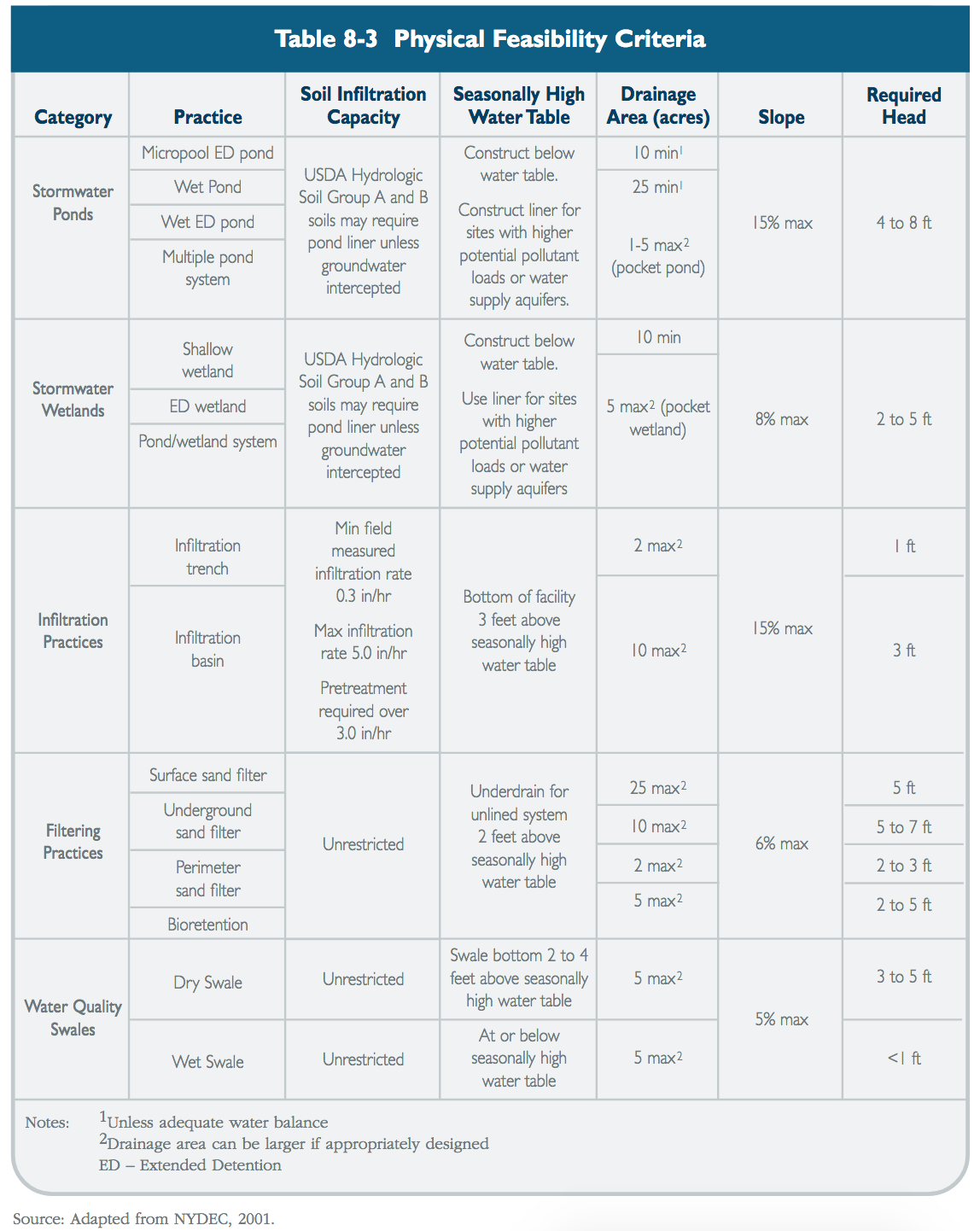
8.4 Downstream Resources
While all sites should provide at least a minimum level of protection, stormwater treatment practices should be tailored not only to the conditions that exist at a particular site, but also the downstream resources that could be impacted by stormwater discharges from the site. As a result, the following downstream resources should be considered in the treatment practice selection process.
Sensitive Watercourses
Streams, brooks, and rivers that are classified by DEP as Class A (fishable, swimmable, and potential drinking water), as well as their tributary watercourses and wetlands, are high quality resources that warrant a high degree of protection. Toxic pollutants such as metals and soluble organics, as well as other contaminants such as bacteria are the primary concern for these waterbodies. Sensitive cold water fisheries, including Class B waters or managed stocked streams, could also be adversely impacted by stormwater runoff with elevated temperatures. In addition, the rate and volume of stormwater discharges from new developments are especially critical to these systems, as they could impact the flood carrying capacity of the watercourse as well as increase the potential for channel erosion.
Water Supply Aquifers
Groundwater is a major source of drinking water in Connecticut for residences that rely on small private wells and larger water distributors. This applies to both water supply aquifers as well as Class GA and GAA groundwaters as defined by DEP. In addition, groundwater is the source of dry weather flows (baseflow) in watercourses, which is critical for maintaining suitable habitat. As a result, it is important to maintain groundwater recharge, as well as to maintain a high quality recharge to groundwater in water supply aquifers and Class GA and GAA waters.
Lakes and Ponds
Lakes and ponds are especially sensitive to sediment and nutrient loadings. Excess sediments and nutrients are the cause of algal blooms in these surface waters, leading to eutrophication and degradation. These conditions often result in costly dredging and rehabilitation projects. In fresh water systems, phosphorus is typically the limiting nutrient, that is, much less phosphorus is needed compared to other nutrients such as nitrogen to create eutrophic conditions. As a result, treatment practices should focus on nutrient, particularly phosphorus, removal for stormwater discharges to lakes and ponds, and watercourses that feed lakes and ponds. Control of phosphorus is also directly related to the control of iron. Certain iron compounds such as ferric iron often have a high scavenging coefficient for metals. Thus, control of phosphorus may have ancillary benefits in the control of metals.
Surface Water Drinking Supplies
Surface waters that supply drinking water are especially susceptible to contamination by bacteria and other pathogens. Other contaminants-of-concern may be defined for specific water supply systems by the owner/operator or the State Department of Health. Treatment practices for sites within drinking water supply watersheds should target these potential contaminants. The Public Health Code also requires a 100-foot separation distance between drainage or treatment practice outlets and public water supply tributaries. Site designs within public water supply watersheds are encouraged to maximize absorption of pollutants by the soil and vegetation.
Estuary/Coastal
Coastal or estuary areas are more sensitive to nitrogen loadings as compared to fresh water systems. In salt water systems, nitrogen tends to be the limiting nutrient as opposed to phosphorus. Bacteria are also a concern given the sensitivity of public swimming and shellfish beds to bacterial loadings.
Table 8-4 summarizes limitations and engineering considerations for stormwater treatment practices based on downstream resources and the receiving environment.
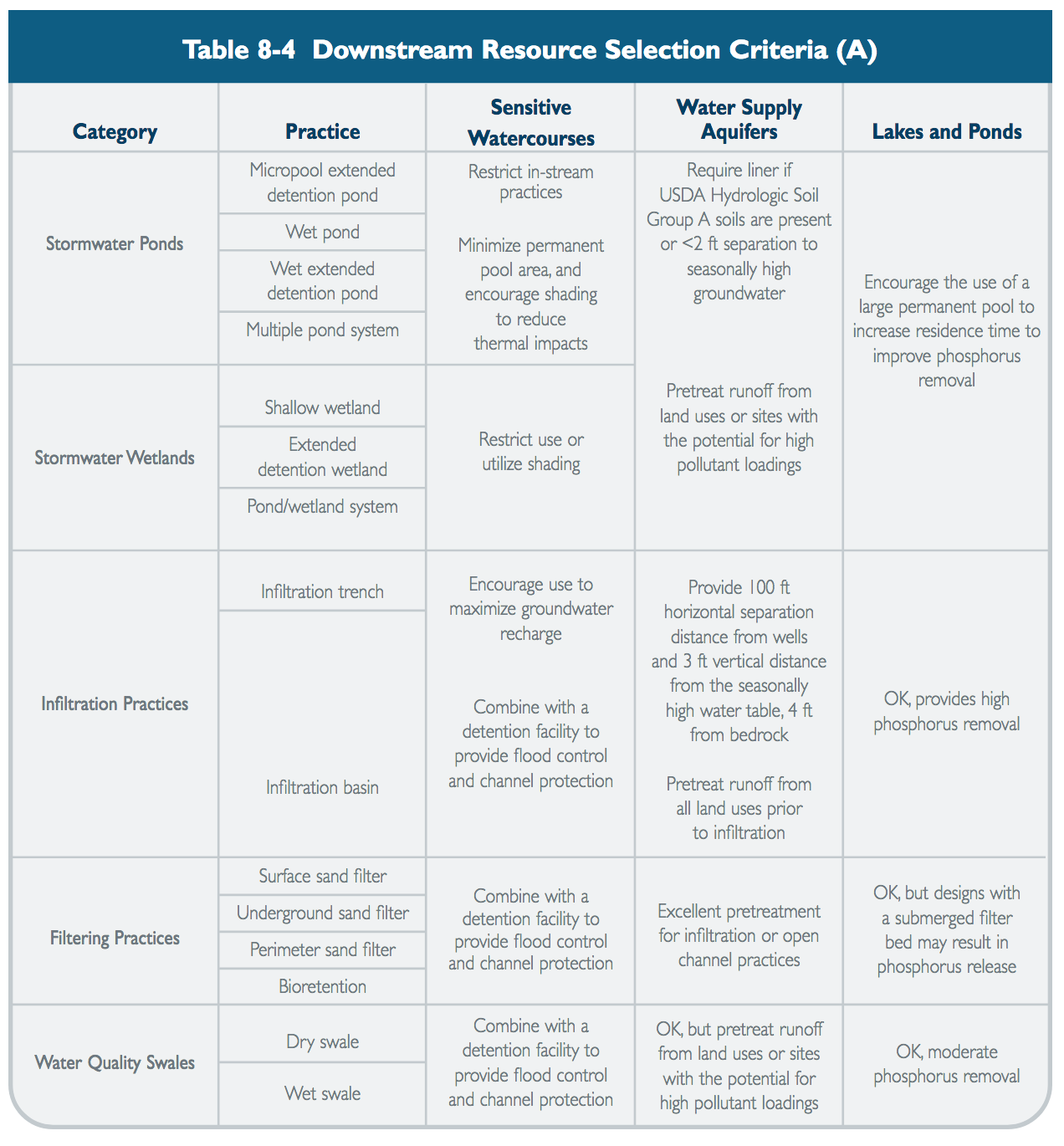
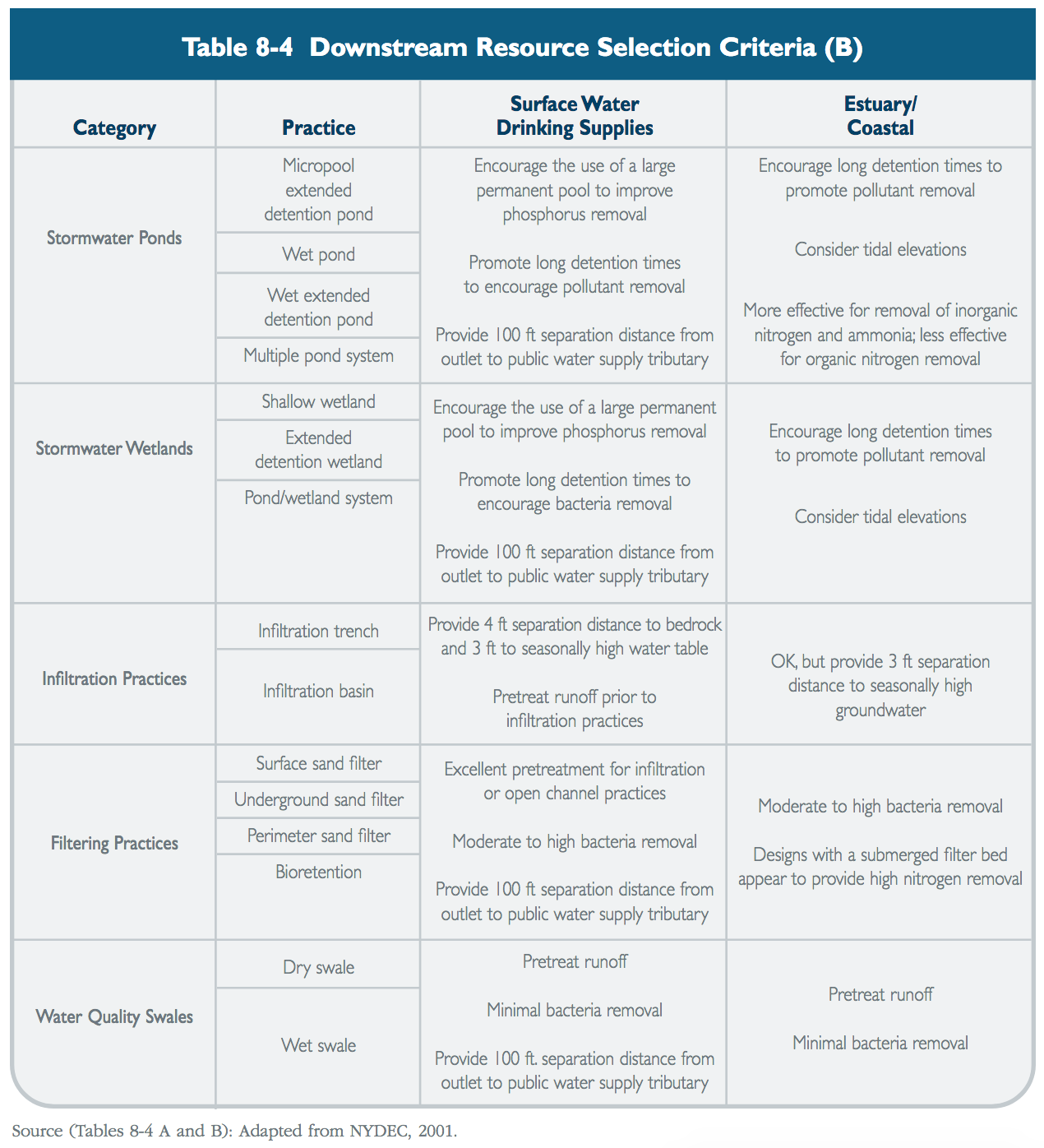
8.5 Maintenance Factors
Regular maintenance is required for the successful long-term operation of any stormwater treatment practice. Accumulated sediment and floatables reduce pollutant removal efficiencies and increase the potential for resuspension as well as sediment reflux. Accumulated debris can also impact hydraulic performance. Some treatment practices require more intensive or more frequent maintenance in order to function as designed. For example, the filter bed of a sand filter needs to be replaced when clogged, and stormwater wetlands need to be “harvested” periodically.
Table 8-5 summarizes the maintenance requirements for stormwater treatment practices. Maintenance sensitivity is a measure of a practice’s susceptibility to reduced performance if not adequately maintained.
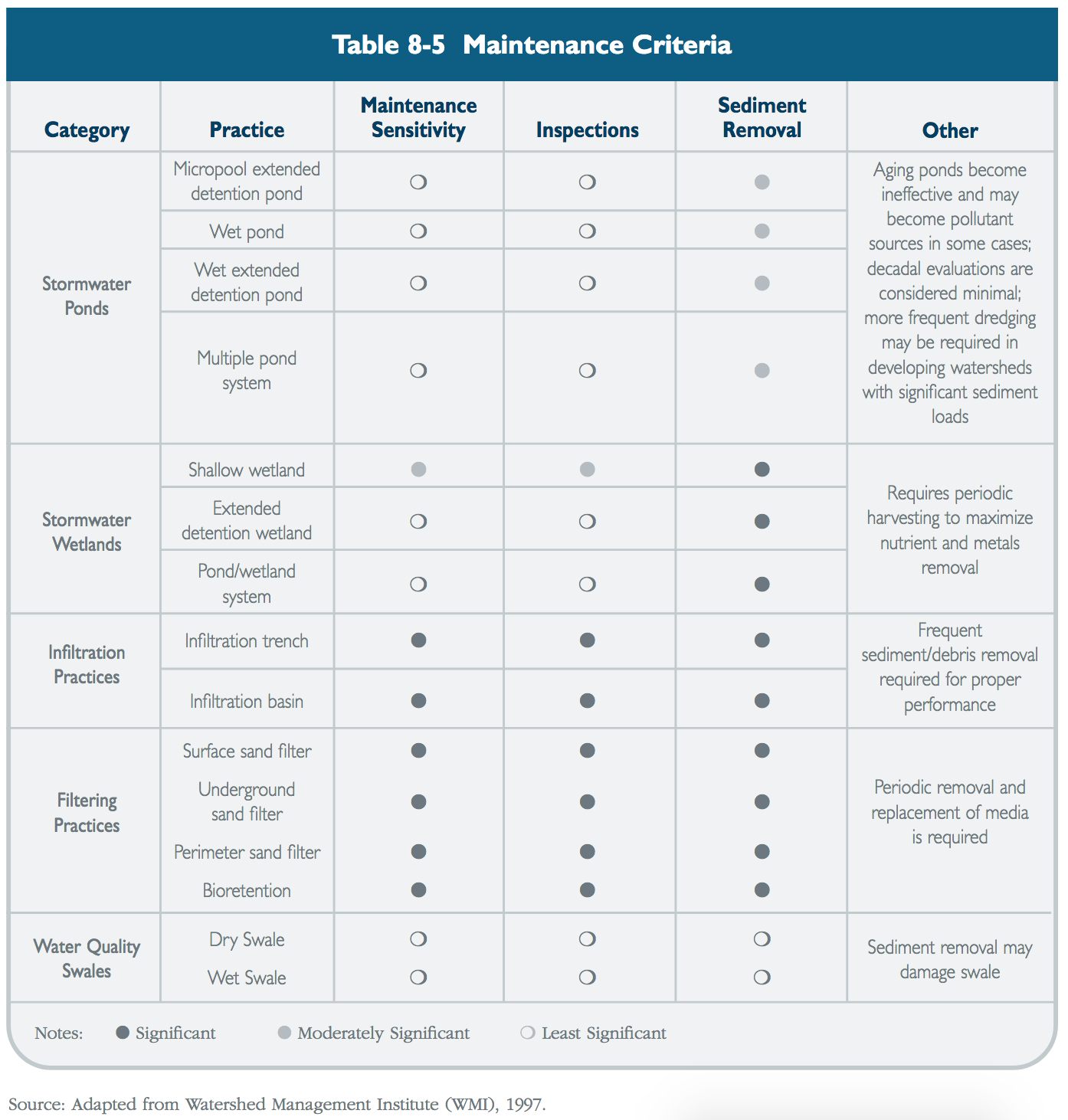
8.6 Winter Operation
In Connecticut, the effects of winter conditions (cold temperatures, snow, ice, etc.) on stormwater treatment practice performance are important considerations. While there may be fewer runoff events during winter months, snow and ice may significantly impact the operation of some treatment practices during winter rain events and periods of snowmelt. The following paragraphs summarize some of these potential impacts.
- Pipe Freezing: Most treatment practices, with the exception of vegetative filter strips, rely on some form of inlet piping, and may also have an outlet or underdrain pipe. Frozen pipes can crack due to ice expansion, creating a maintenance or replacement burden. In addition, pipe freezing reduces the hydraulic capacity of the system, thereby limiting pollutant removal and creating the potential for flooding (Center for Watershed Protection, 1997).
- Ice Formation on the Permanent Pool: Ice cover on the permanent pool causes two problems. First, the treatment pool’s volume is reduced. Second, since the permanent pool is frozen, it acts as an impermeable surface. Runoff entering an ice-covered pond can follow two possible routes, neither of which provides sufficient pollutant removal. In the first, runoff is forced under the ice, causing scouring of bottom sediments. In the second, runoff flows over the top of the ice, receiving little or no treatment. Sediment that settles on top of the ice can easily be resuspended by subsequent runoff events (Center for Watershed Protection, 1997).
- Reduced Biological Activity: Many stormwater treatment practices rely on biological mechanisms to help reduce pollutants, especially nutrients and organic matter. For example, wetland systems rely on plant uptake of nutrients and the activity of microbes at the soil/root zone interface to break down pollutants. During cold temperatures (below 40BF), photosynthetic and microbial activity is sharply reduced when plants are dormant during the non-growing season, limiting these pollutant removal pathways (Center for Watershed Protection, 1997).
- Reduced Soil Infiltration: The rate of infiltration in frozen soils is limited, especially when ice lenses form (Center for Watershed Protection, 1997). This reduced infiltration significantly impacts the operation of infiltration practices and other treatment systems that rely on infiltration of stormwater into the soil.
Table 8-6 summarizes winter operation and cold weather considerations for stormwater treatment practices. Chapter Eleven includes design guidance for mitigating the potential effects of cold weather on treatment practice operation and performance.
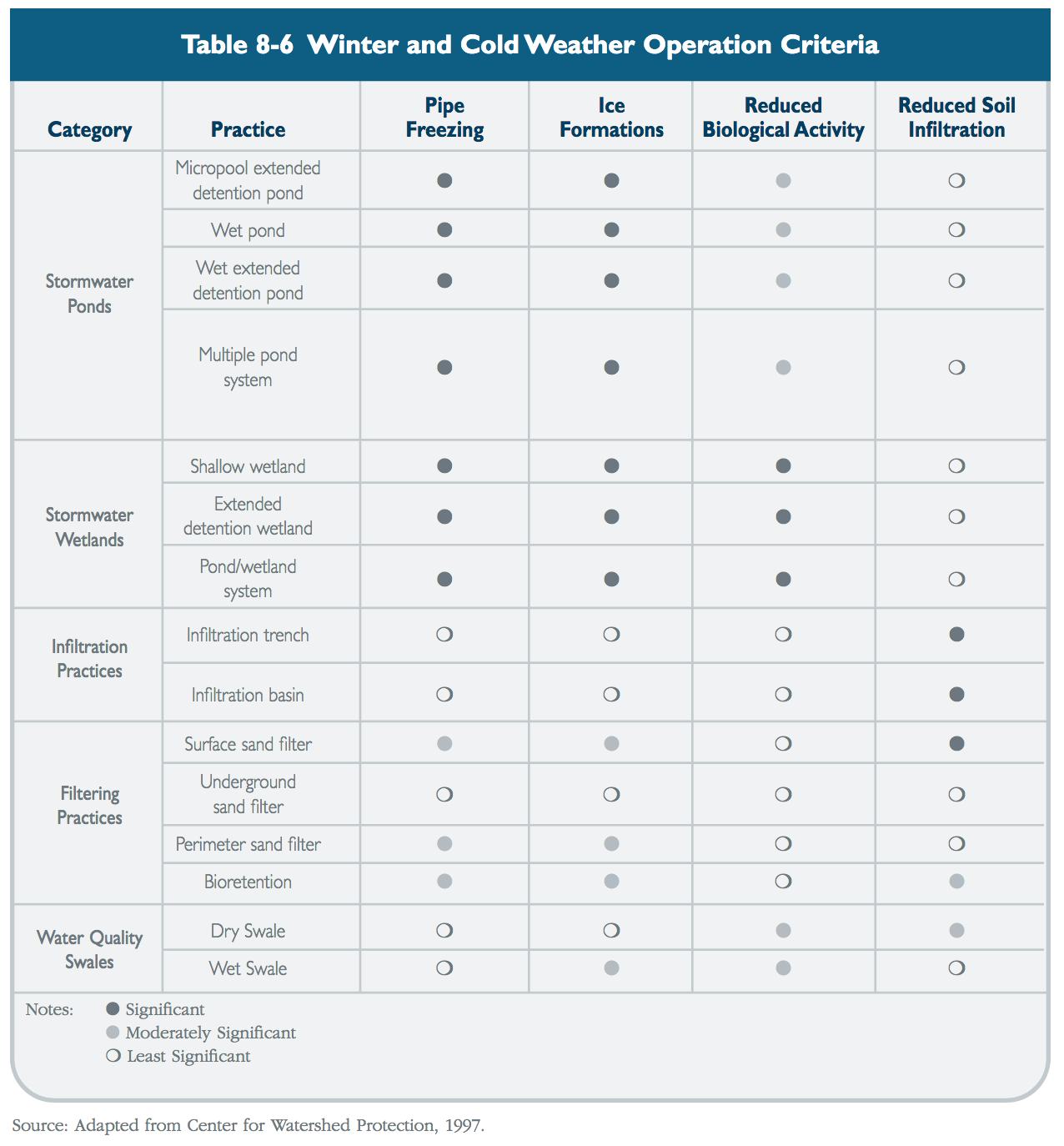
8.7 Nuisance Insects and Vectors
Some stormwater treatment practices can provide breeding habitat for mosquitoes, ticks, fleas, and other vectors (organisms that can transmit pathogens that can cause an infectious disease such as West Nile fever, Lyme disease, and St. Louis encephalitis). Mosquitoes are one of the most prevalent nuisance insects in Connecticut, as well as vectors of West Nile fever and Eastern Equine Encephalitis virus, and therefore are the focus of many municipal control programs.
The approximately 48 species of mosquitoes in Connecticut can be broadly grouped into two categories - those that lay eggs directly on a stagnant water surface (“surface water mosquitoes”), and those that lay eggs on a moist substrate (mud, leaf litter) and hatch at a later date when flooded by rain or tides ("floodwater mosquitoes"). The eggs of floodwater species can lie dormant for several years until conditions are right for hatching. Usually however, the eggs will survive over winter and hatch with the spring thaw. Eggs of "surface water" mosquitoes do not survive over the winter. The adults survive during the winter in caves, basements, and other similar environments and emerge with warmer weather. The rate of development (from hatching to emergence) is controlled by photoperiod (length of day) and water temperature. In the spring, this may take up to a month and a half. In the summer, it may take as little as 1 to 2 weeks. Generally speaking, relative to stormwater basins and other treatment practices, there is the potential for mosquito breeding if water is allowed to stand/stagnate, in the absence of predators, for more than 7 to 10 days in the summer (Roger Wolfe, Mosquito Management Coordinator, DEP 2003).
When located in residential and urban areas, stormwater treatment practices that hold water for an extended period (longer than 7 to 10 days) have the potential to become new sources of mosquito habitat or aggravate existing mosquito problems. According to national studies conducted by the California Department of Health Services and the California Department of Transportation (1998), stormwater treatment practices that maintain permanent sources of standing water in sumps, basins (wetlands, perimeter sand filters), or wet swales provide habitat for immature mosquitoes and frequently support relatively larger mosquito populations. Catch basins with sumps provide ideal mosquito (particularly species of the genus Culex) breeding conditions – stagnant, organically rich water in a shaded and humid environment devoid of predators. In contrast, stormwater treatment practices designed to drain more rapidly (dry swales, filter strips, extended detention structures, and infiltration structures) provide less suitable habitats and rarely harbor mosquitoes. Treatment practices that employ a larger permanent body of open water (i.e., ponds) generally pose lower risk of mosquito breeding since larger open bodies of water are not conducive to mosquito egg laying and, unless extremely polluted, a pond community structure will support a natural predator population. Improperly maintained structures can also result in sediment and debris accumulation that can contribute to conditions of prolonged standing water.
Proper siting, design, and maintenance of stormwater treatment practices are important factors in minimizing the potential for these structures to become mosquito-breeding areas. Stormwater ponds, wetlands, and other treatment practices that maintain standing water for a prolonged period should be carefully considered and designed in residential, commercial, and other urban areas where mosquito control is a concern. Key design considerations for mosquito control include:
- Limiting water retention or draining time to 5 days or less (based on a 7 to 10 day summer breeding period and a factor of safety). Structures designed with sumps or basins that retain water permanently or longer than 5 days should be sealed completely to prevent entry of adult mosquitoes.
- Maintaining pond and wetland water quality sufficient to support mosquito-feeding fish and other aquatic predators. Stormwater ponds and wetlands often develop mini-ecosystems where birds, frogs, and other insects feed, many of which are natural predators of mosquitoes and other nuisance insects. Ponds can also be stocked with fish native to Connecticut that feed on mosquito larvae such as banded killfish, golden shiners, and pumpkinseed sunfish. The DEP Inland Fisheries Division should be consulted regarding species selection and permitting requirements. A liberation permit is required to introduce these and other fish into ponds and other water bodies in Connecticut. Other natural predators of mosquitoes such as dragonfly nymphs can also be used.
- Maintaining permanent pond water depths in excess of 4 feet to preclude invasive emergent vegetation such as cattails. Dense emergent vegetation provides mosquito larvae with refuge from predators.
- Designing ponds to allow for easy dewatering of the basin when necessary.
- Providing sufficient slope on basin floors and swales for adequate drainage.
- Ensuring sufficient separation distance to the seasonal high groundwater table for infiltration structures.
- Sealing potential mosquito entry points in underground stormwater treatment devices (adult female mosquitoes can use openings as small as 1/16 inch to access water for egg laying).
Chapter Eleven includes additional design guidance to avoid or reduce mosquito-breeding problems for individual treatment practice categories.
8.8 Natural Wetlands and Vernal Pools
Careful consideration should be given to the selection, design, and location of stormwater treatment practices on or near sites with natural wetlands and vernal pools. Conventional stormwater management techniques often have adverse impacts on biodiversity. Wildlife species that migrate seasonally between forested upland habitats and vernal pools (and other small wetlands) are particularly susceptible (Calhoun and Klemens 2002). Populations of turtles, snakes, small mammals, frogs, and salamanders often decline in areas with intensive stormwater management measures. Curb and catch-basin systems, particularly in combination with hydrodynamic separators, can intercept, trap, and kill amphibians and other small animals crossing roads. Stormwater wetlands and ponds that are placed near vernal pools can also threaten pool-breeding amphibian populations. Stormwater ponds and wetlands can serve as “decoy” pools, intercepting amphibians as they migrate in spring to their vernal pool breeding habitats. Amphibians often deposit their eggs in these artificial wetlands. The eggs rarely survive due to sediment and pollutant loads, which are concentrated in these stormwater treatment systems. Fluctuations in water quality, water quantity, and temperature within these decoy wetlands can also cause reproductive failure. Many vernal pool species are extremely sensitive to hydroperiod (duration of flooding). Stormwater management can de-water (or shorten the hydroperiod) vernal pools. This impacts species that require longer hydroperiods such as marbled salamanders. Stormwater management can also increase the hydroperiod of vernal pools, impacting species that require shorter hydroperiods (e.g., fairy shrimp). In addition, constructed wetlands tend to support highly adaptable, widespread, “weedy” species (e.g., bullfrogs or green frogs), which prey upon, or successfully out-compete, vernal pool-breeding amphibians.
Stormwater ponds and wetlands should be located at least 750 feet from a vernal pool and should not be sited between vernal pools or in areas that are primary amphibian overland migration routes, if known (Calhoun and Klemens 2002). Using natural wetlands as stormwater treatment practices is also highly undesirable. Increases in pollutants, sediments, and “flashiness” of the system degrade the wetland and result in a reduction habitat complexity, leading to reductions in biodiversity. In general, stormwater runoff to vernal pools should be maintained at pre-construction levels to avoid increases or decreases in water levels and hydroperiod. Chapter Eleven contains additional design guidance to avoid impacts to natural wetlands and vernal pools.
Additional Information Sources
U.S. Department of Agriculture (USDA). Natural Resources Conservation Service (NRCS). 2002 (draft). Soil Suitability for Stormwater Management Practices. URL: http://www.ct.nrcs.usda.gov . Contact: Kipen Kolesinskas, State Soil Scientist, 344 Merrow Road, Tolland, CT 06084-3917, (860) 871-4047.
References
Calhoun, A.J.K. and M.W. Klemens. 2002. Best development practices: Conserving pool-breeding amphibians in residential and commercial developments in the northeastern United States. MCA Technical Paper No. 5, Metropolitan Conservation Alliance, Wildlife Conservation Society, Bronx, New York.
Center for Watershed Protection (CWP). 1997. Stormwater BMP Design Supplement for Cold Climates. Ellicot City, Maryland.
New York State Department of Environmental Conservation (NYDEC). 2001. New York State Stormwater Management Design Manual. Prepared by Center for Watershed Protection. Albany, New York.
Urban Water Resources Research Council of the American Society of Civil Engineers (ASCE) and Wright Water Engineers, Inc. 2001. National Stormwater Best Management Practices (BMP) Database.
U.S. Environmental Protection Agency (EPA). 1993. Handbook of Urban Runoff Pollution Prevention and Control Planning. EPA 625-R-93-004. Washington, D.C.
Winer, R. 2000. National Pollutant Removal Database for Stormwater Treatment Practices, 2nd Edition. Center for Watershed Protection. Ellicott City, Maryland.